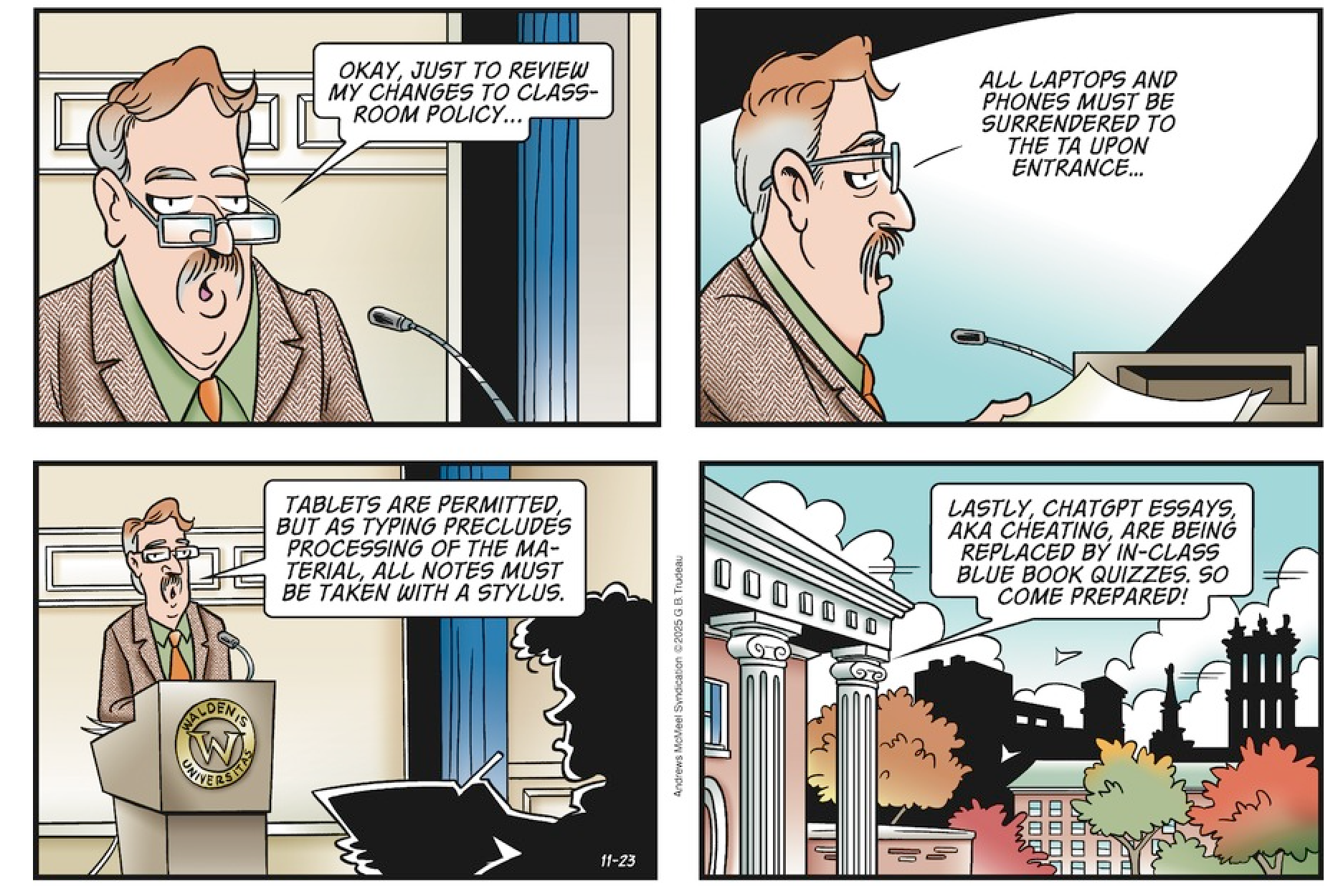Happy World Linguistics Day
Today is (not very officially) World Linguistics Day, celebrated on the birthday of Ferdinand de Saussure. It started with "National Linguistics Day" in the UK, noted by LLOG in 2024.
Read the rest of this entry »
AI in education
Sunday's Doonesbury addresses possible restrictions on the use of AI in higher education. Here are the middle four panels:
Read the rest of this entry »
Canting Crew words
As promised, here are a few fun words that I learned by skimming a 17th century slang dictionary.
Read the rest of this entry »
Isidore of Seville and his Etymologiae (7th c. AD)
Tomorrow I will be delivering the keynote address to the international conference on "China and Greece. Ancient Ecumenisms in the Mirror", to be held at the Dipartimento Asia, Africa e Mediterraneo (DAAM) of Università degli Studi di Napoli "L'Orientale" in late November (actually tomorrow, Tuesday the 25th; here's the zoom link for my talk at 9:30 AM EST).
In preparing for my lecture on "Isidore of Seville and the medieval concept of the ecumene", I was delighted to learn more about this remarkable man. Isidorus Hispalensis, who lived from ca. 560-636. was a Hispano-Roman scholar, theologian, and the archbishop of Seville. During his lifetime, he was active in the politico-religious affairs of Iberia, including most prominently the conversion of the Visigothic kings to Chalcedonian Christianity. After his death, Isidore's legacy was based largely on his celebrated Etymologiae, an encyclopedia that brought together extracts of works from classical antiquity that would otherwise have been lost.
Read the rest of this entry »
The Canting Crew
The first English-language slang dictionary:
A New Dictionary of the Terms Ancient and Modern of the Canting Crew, in Its Several Tribes, of Gypsies, Beggers, Thieves, Cheats, &c, With an Addition of some Proverbs, Phrases, Figurative Speeches, &c Useful for all sorts of People (especially Foreigners) to secure their Money and preserve their Lives; besides very Diverting and Entertaining, being wholly New.
Read the rest of this entry »
Weirdly specific words
Most words have different senses and meanings depending upon the context in which they are used, hence the need for multiple definitions in dictionaries. Philip Taylor has come across this article about:
8 Words That Are Only Used in One Weirdly Specific Context
Think about it: have you ever heard someone say they had “extenuating errands”?
By Sam Hindman, Mental Floss (11/23/25)
Read the rest of this entry »
Gendered word counts again
The "words per day" thing has mostly gone quiet since it erupted in the media nearly 20 years ago — but here's a sensible replay:
Read the rest of this entry »
Comparative Common Shē and Common Neo-Hakka
I have observed the author working on this 749 page volume for many years, so it is with great rejoicing that it is available in time to send to friends, colleagues, and students as a Yuletide gift:
South Coblin, Common Shē and Common Hakka-Shē: A Comparative Study
Language and Linguistics Monograph Series 68
Institute of Linguistics, Academia Sinica (Taipei: November, 2025)
Introduction
The present work is divided into two parts. Part I is devoted to the reconstruction of the phonology of Common Shē, the ancestral form of the closely related Sinitic dialects spoken by the Shē ethnic minority of China. The approach applied is the classical comparative method, in which modern data from seventeen modern dialects are subjected to comparative reconstructive analysis. Data from additional Shē varieties are also adduced as needed. The end product of these procedures is a hypothetical phonological system, which for the sake of brevity we call Common Shē, though this term should more precisely encompass not only phonology but also syntax and lexicon.
Read the rest of this entry »
L'error
In our discussion of part III of Elle Cordova's Grammarian Saga, "Grammarian vs Errorist showdown at the secret L'error", there was some back-and-forth about whether or not error could stand it for the nucleus of lair.
AntC wrote "I can't smudge 'error; into a single syllable", and I responded that "Elle Cordova does it by brute force — I don't think 'air' is her normal pronunciation of 'error'".
But looking into pronunciations of error on the internet, I've found that her "l'error" ~ "lair" pun is, in fact, pretty plausible.
Read the rest of this entry »
Ask LLOG: Alternative standard pronunciations?
In an email, Coby Lubliner observed that many English words have more than one standard pronunciation. He asked whether there has been any academic discussion of this general issue, and noted that he isn't familiar with any other language with as much variety in its standard pronunciations.
Read the rest of this entry »
Uyghurish Mandarin and shrike-tongued barbarians
I, for one, don't think it's the least bit funny.
Uyghur pronounciation
The way Uyghurs speak Mandarin is now a joke
For many it’s not funny, given the political heat around language choices
Economist (Nov 13th 2025)
The article begins with a viral joke, which Economist doesn't bother to explain (I will, though, at the end of the first paragraph):
Scroll through posts about Xinjiang on Chinese social media and an odd phrase soon appears: “Apple U”. It is a pun that mimics how some Uyghurs, the largest ethnic minority in Xinjiang, a region in China’s far north-west, pronounce “Hey, friend” in Mandarin. This meme is part of a growing trend online for using nang yan wen, or “naan Mandarin”—a way of writing and talking that wags have named after Xinjiang’s staple flatbread. Videos tagged with the term have amassed more than 1.7bn [VHM: !!!] views on Douyin, TikTok’s sister app in China, since the start of the year.
Read the rest of this entry »

